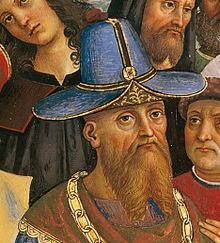Continuing on from my previous post on Benozzo Gozzoli's masterpiece "The Journey of the Magi". We can begin to examine the figures depicted in the painting and see how they relate to 1439's visit by the Byzantine court to Medici Florence...
The 3 Byzantine Kings
Each Magi is accompanied by a retinue, each with a dominant colour in their garments and harnesses: white for Caspar, green for Balthazar, red for Melchior. The three retinues also adhere to chivalric norms. Each with a squad of twelve made up of three pages on horseback making up the vanguard to announce their lord, two knights carrying a sword (the symbol of authority) and the gift of their lord and finally lightly armed pages on foot who escort the lord directly. The choice of the three colours is no accident as they were the Medici family colours.
Representing Melchior is the Greek Patriarch, Joseph II, who journeyed with the Emperor from Constantinople in 1439 (and indeed entered Florence ahead of him). Joseph aged 79 at the time of the Council, died on the 10th June shortly before the Union was signed and was buried in Florence at Santa Maria Novella.
Representing Balthazar is the Emperor John VIII. Much has been made of his toufa-style headdress, which is almost certainly a flight of Gozzoli fancy, but John VIII did make an impression on Florentine society with his strange and elaborate hats. The feathers in the painting’s headdress are subtly red white and green, so we can say Balthazar has been crowned in Medici colours.
The identity of the first two magi is largely agreed upon. The identity of the young king is not. Very often it is stated that this is Lorenzo di Medici, but as I said earlier, this would make little sense in 1459. Not only does a Florentine not fit with the allegory of wise men coming from the east which the first two kings clearly set out, but as mentioned before, Lorenzo was not even close to being the family’s heir apparent. Lastly, one must also consider the implications of a Medici elevated to the role of a king in a painting in the Republic of Florence. Whatever the reality of the power the Medici drew from their wealth and connections, they had no claim to kingship.
There is a clear candidate for the Caspar king. When John VIII travelled west from Constantinople he left his brother Constantine as regent. He chose Constantine because he was the dependable brother (and would prove a worthy successor when John died in 1448). John brought with him his brother Demetrios. Demetrios was the infant terrible of the Palaiologos family. He seems to have tried to defect to the Turks when he was sixteen and it is implied in letters that his presence on the trip to Italy stemmed from fears he would use the Emperor’s absence to try and cause trouble. When the council moved to Florence, Demetrios lingered in Venice for three weeks before answering his brother’s summons (and so the order of entry of the kings nicely mirrors the historical arrival to Florence). Young, handsome and charming, Demetrios made an impression on Florentine society.
Demetrios was an anti-unionist and left the council four days after the Patriarch’s death (along with Gennadios and Plethon) without permission of the Emperor, causing a rift which led later to an uprising (not for the last time, Demetrios called in the Turks for support against a brother). Knowing he could be trouble, Constantine made Demetrios despot of half the Morea when he took the throne in 1449. That removed him from Constantinople and meant he survived the fall in 1453. As of 1459, Demetrios might have been considered to hold the most legitimate claim to being Byzantine Emperor – and there must have been some hope that Mantua would spark a crusade that would restore the porphyry throne.
In tackling the argument for Demetrios not Lorenzo, we should also address a fourth rider in the entourage. Leading the old king is a young man on a horse with a hunting leopard perched at his side. He is not dressed as a page and although not one of the magi, is clearly a figure of importance. His colouring and looks are very similar to the young king’s. For this reason, many interpretations say this is Giuliano Medici, younger brother of Lorenzo. But if we reject Lorenzo as the young king, this cannot be the case.
Once again, the Byzantine delegation has a suitable candidate for this figure. A third Palaiologos brother was present at Florence. Although not originally part of the delegation, Thomas Palaiologos was dispatched by Constantine with a message for John while he was still in Florence (possibly with news that both John and Demetrios’s wives were fatally ill back home with plague). If the young king is Demetrios, then it may well be Thomas Palaiologos sitting with his hunting cat. In 1459 Thomas was in control of the other half of the Morea and his bickering with Demetrios would be the excuse Sultan Mehmed used to invade the following summer. Demetrios complied with the Sultan, handed his daughter into the harem and lived out his life on a Turkish pension. Thomas fled west and lived out his days as Pius’s guest in Rome.
There seems a very firm link between the four key figures of the magi procession and the three imperial Palaiologoi brothers and Patriarch who headed the procession to Florence of 1439. It is the only combination that holds the allegorical meaning of the work together. The idea that Lorenzo and Giuliano (but not their cousin Cosimino) would be mixed in as 'magi' with two random Greeks makes very little sense indeed. Instead we will find the male Medici gathered together to one side of the procession and that is the subject of the next post...







No comments:
Post a Comment
Note: only a member of this blog may post a comment.